Something that I really love about drums is the fact that you can get a good intermediate drum set and it will work perfectly in many professional situations.
If you’re looking to get a new drum kit, you’d be shocked at how good intermediate drum sets can sound.
Top 3 - Intermediate Drum Kits
Preview | Product | Price |
|---|---|---|
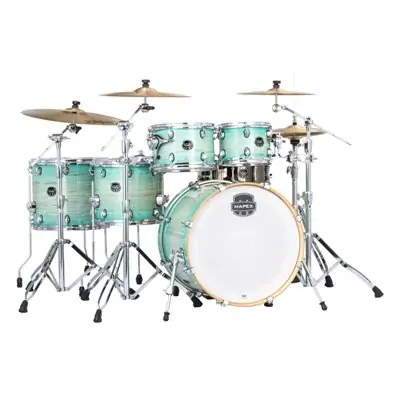 | ||
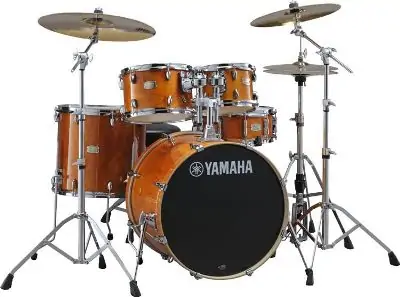 | ||
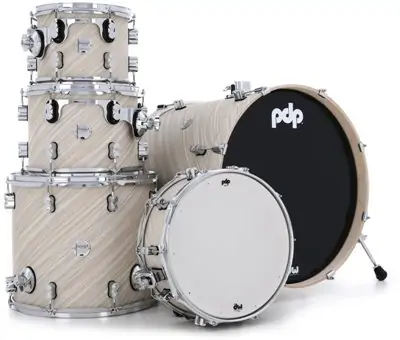 |
There are so many high-quality kits on the market that have surprisingly good qualities to them.
Whether you’re a beginner, intermediate, or advanced drummer, getting a mid-range drum set is a viable option for anyone. I’m going to show you some of my favorite drum sets around the $1,000 mark and explain why they are my top picks.
5 Best Intermediate Drum Sets Around $1,000
1. Mapex Armory Studioease 6-piece
Mapex isn’t the most popular drum company around. While their higher-tier Black Panther kits are quite well-known, I’d argue that not many drummers are aware of any of their lower-priced kits. However, this Armory Studioease kit is something that I feel is incredibly underrated.

Mapex Armory Studioease
This particular version is the Fast Tom setup that has rack toms that are shallower than your typical rack toms. As a drummer who loves playing fast patterns around the drums, I love how the shallow toms cater well to that. They have less sustain than standard toms and get out of the way very quickly.
Another great thing about the shallow depth of the toms is that you can place them directly above the bass drum without worrying about them touching it. Toms with deeper depths need to be placed at an angle if you want to keep them from being in contact with the kick.
If you want to have flat tom angles, you have to raise your drum throne pretty high. That’s not the case with these shallow Mapex toms.
Even though the toms are shallow and sit in the upper-tier sound range, the two floor toms more than make up for it with their beefy tones. I found the bass drum having immaculate bottom-end as well. So, you’re completely covered when it comes to sound diversity.
If you’re a fan of the sounds but you don’t want the shallow toms, Mapex also sells this kit in a 5-piece version that has standard tom depths. Overall, both kits sound fantastic and are priced very reasonably for the quality they offer. They also come with a steel snare drum that is fairly versatile in its sounds.
One thing to note is just how good their Tomahawk steel snare sounds for rock and metal genres. I've played with this particular snare before as part of a completely different Yamaha kit that I own, and it just has this incredibly tight but deep, growly sound.
This is particularly where Mapex really shines — every single one of their drums has a certain tightness that makes it a very clean kit for very precise drumming.
It doesn't necessarily have to just be in rock and metal genres, though that's where most drummers do end up using this brand. Because of the price, I've actually used the Mapex Armory on one gig playing British drum and bass (or "jungle," as some people call it).
This is a type of electronic music style that has the drummer playing double-time sped-up loops. Imagine taking the famous Funky Drummer loop and playing it on a sampler at twice the speed — well, that's drum and bass for you.
It's super challenging but really cool to play live, and it's making a comeback with pop artists like Kenya Grace. Ever since that gig, I've always used Mapex drums when playing very fast rock music or simulating electronic loops in the studio.
I also have to mention that if you're using these for live gigs, the colors and paint job are incredible. I can't even believe they have this level of art detail at such a low price. These drums look like expensive vintage Ludwig kits from afar.
One thing that I’m not a fan of is how the toms are mounted, though. While I think it’s good that the kit replicates pro kits by having the toms mounted onto cymbal stands, I feel that the system isn’t implemented too well.
It can be frustrating to mount the toms in the exact way you want due to the tom mounts not locking tightly in place when you tighten them. This can get even more frustrating if you plan on setting up the kit in different places often.
PROS
CONS
2. Yamaha Stage Custom Birch
The Yamaha Stage Custom Birch is one of my favorite drum kits. It has a solid reputation for being one of the most affordable high-quality kits you can buy. It’s mainly because the sounds of the drums are of professional quality, and the kit is easy to tune up. It can also handle any situation you put it in with relative ease.
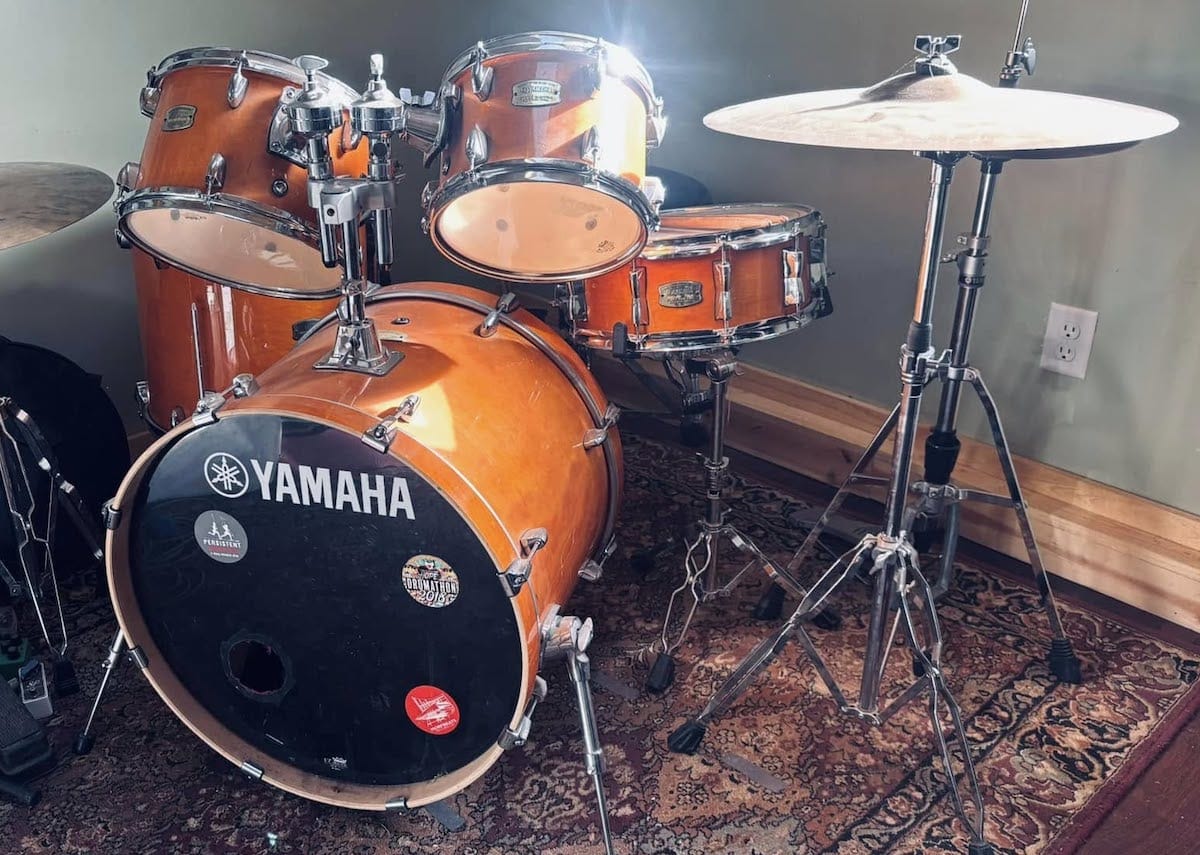
Yamaha Stage Custom Birch Kit
You are unlikely to find a better drum kit for the price, making the Stage Custom an incredibly enticing option to go with.
My main reason for loving this kit is the tom mounting system. You’re going to hear me speaking about hardware quite often, but that’s exactly what you should be looking for in intermediate kits. Most of them sound similar but the quality of their hardware is what sets them apart.
Anyway, this kit uses Yamaha’s YESS mounting system which is what they use on all of their drum kits. It’s a simple way of mounting the toms to the bass drum with a few parts. However, I feel that it’s one of the best mounting systems around as I always have such an easy time getting my toms to feel comfortable on a Stage Custom kit.
The rest of the hardware on the kit is immaculate. My only concern is the lugs on the snare drum. They’re known to break every now and then and replacing them can be quite a mission. It’s fairly common for drummers to upgrade their snare drum when using a Stage Custom.
Because of the great construction standards of Yamaha, this kit sounds like some of the kits two or three times its price. In fact, if you just upgrade the heads, it's almost identical to a vintage Recording Custom kit.
That's what I love about Yamaha kits, depending on how you modify them. You can really get an all-around versatile, professional, and amazing-sounding kit not just for performing but for recording.
The toms sound perfectly tuned and stay that way, even in transport. It also has one of my favorite kick drum sounds for Latin music. It has a really nice low end without having as many subs as a brand like Sonor, for example.
That's why I would go with this kit if you're looking for something fairly affordable that can get you through every genre possible.
As a suggestion, I don't know why, but to me this kit sounds best with Zildjian cymbals. Of course, you can work with any brand, but for some reason, the overall tone and general pitch of the drums sounds great with this particular brand.
Try it out for yourselves — I would especially recommend using a 14" Zildjian I Hi-hat. The precision response matches the Yamaha like a glove. It's also a great value and one of the more affordable members of the Zildjian family.
This is a kit that will last you a lifetime thanks to how good it sounds. You could get a pro snare drum and you’d be able to use this kit in recording studios with no problem.
PROS
CONS
3. PDP Concept Maple
The PDP Concept Maple is kind of like the maple equivalent of the Yamaha Stage Custom (you can also check out my article on birch vs maple drums). These two kits are often compared with each other as they’re fairly similar in price and quality.

PDP Concept Maple Kit (this one is the 6-piece variant).
There are a few things about the PDP Concept Maple that I feel are better compared to the Stage Custom, though. There are also a few things that are worse, but let’s stick with the good for now.
I’ll start with my favorite things about this kit and those are the beautiful finish options you get. Out of all the finishes on these intermediate kits, I don’t think any look as good as the ones on the PDP Concept Maples.
They’re mostly satin finishes that look incredibly clean and professional. If I were playing drums in a music video, these are the types of finishes I’d want to have to make my drum set look as good as possible.
In terms of sound, the maple shells provide the kit with fairly warm tones. They’re a lot rounder than the punchy birch tones of the Stage Custom kit. They’re especially deep as you go down to the bigger drums. It’s quite common to see Concept Maple kits being used in churches. I think the warm tom sounds have a huge role to play in that.
The drums sound pretty good with the stock drum heads. However, you’ll be surprised at how much better they can sound with some higher-quality heads placed on both resonant and batter sides of each drum.
Another thing I love about this kit is the MAG throw-off on the snare drum. You’ll hear me saying this about every DW or PDP kit I ever speak about, but the MAG throw-off is something I wish that every snare drum had. It makes turning your snares on and off such a quick and smooth process.
Similar to the Yamaha Stage Custom, I feel that the snare drum is the weak point of this Concept Maple kit, even with the MAG throw-off. It’s perfectly usable but replacing it with a higher-quality snare will take your drum kit sound to a whole other level.
When I saw the PDP Concept Maple for the first time in the studio during a recording session, I really loved the sound. I wasn't the drummer on this particular date, but we were recording an artist from Nashville who was doing some beautiful Daniel Lanois-type Americana music, and the drummer was playing this kit with mallets.
It's a beautiful sound, almost cinematic in nature, as the reduced stick attack creates a pleasantly muffled beginning. This is where a maple kit truly shines — delivering a warm tone with enhanced low frequencies.
In contrast, if you were to play a Mapex kit with mallets, it would sound like you're playing a bunch of phone books or buckets because there's very little decay, especially on toms, since they're already so tight-sounding.
So if you're looking to play slower material, this PDP Concept Maple is perfect. It also shines at lower-intensity gigs like coffee houses or small venues, or intimate small room showcases at festivals like SXSW.
PROS
CONS
4. Gretsch Catalina Maple
Even though the Gretsch Catalina and the PDP Concept are both maple kits, they sound vastly different from each other. This Catalina Maple kit has so many unique qualities that I feel separate it drastically from all the kits we’ve gone through so far.
For me, the main drawcard of this kit is musicality. The drums have a vintage sound to them that dynamically contrasts what you’re typically used to. One way of explaining this is that the drums sound surprisingly good with the stock drum heads.
These heads are only 1-ply, but I think that 1-ply heads thrive with this kit way more than they do with any of the others.
The drums have singing tones that resonate fairly well. I think the Catalina Maple is one of the best kits on this list to get if you’re a drummer who plays multiple styles of music.
I’ve played on Catalina kits in jazz environments where the toms are tuned high and resonating. I’ve also played on Catalina kits that have low tunings for hard rock bands.
If you’re a musical drummer who loves to get creative behind the kit, the Gretsch Catalina Maple is a kit you should consider. Gretsch drums typically have musical vibes to them. I think that’s why so many jazz drummers play Gretsch kits.
Besides jazz, Gretsch kits have always been the go-to for urban genres and hip-hop, at least for me and for many of the session drummers that I've seen in New York and LA.
One of the reasons for this is that they do have that vintage tone, but with more modern precision. So if you're into the old-school '70s sound that was later revived by artists like Anderson .Paak and, most recently, for Sabrina Carpenter's massive hit "Espresso," then look no further than a Gretsch maple kit.
The Catalina in particular has slightly more decay and resonance than a lot of other vintage Gretsch kits, particularly because it’s outfitted with Remo heads. That actually can work to your advantage because it makes the kit a lot more versatile than just getting that vintage tone.
I suggest you look for this particular kit at your local store and give it a test drive. Try different genres on it, and you'll see what I mean. It sounds quite unique, which is rare when you're looking at intermediate-level drum kits.
Another plus side to this kit is the sheer quality of sound it offers at such an affordable price point. I recently heard Mike Johnston talking about how he would have never dreamed of attaining such a high-quality kit for less than $1,000 when he was a working drummer in the early 2000s.
My only gripe with the Catalina Maple kit is the tom mount. This is something that I dislike about all of Gretsch’s kits. While the toms are mounted pretty sturdily, it takes a lot of time and effort to get them to that position in the first place.
PROS
CONS
5. Tama Superstar Classic
The final kit on the list is the Tama Superstar Classic. It’s yet another maple drum kit. However, I feel that this kit really thrives in the low-end of the sound spectrum. All the drums are deep and punchy, with the bass drum being the most significant and impactful one out of all of them.
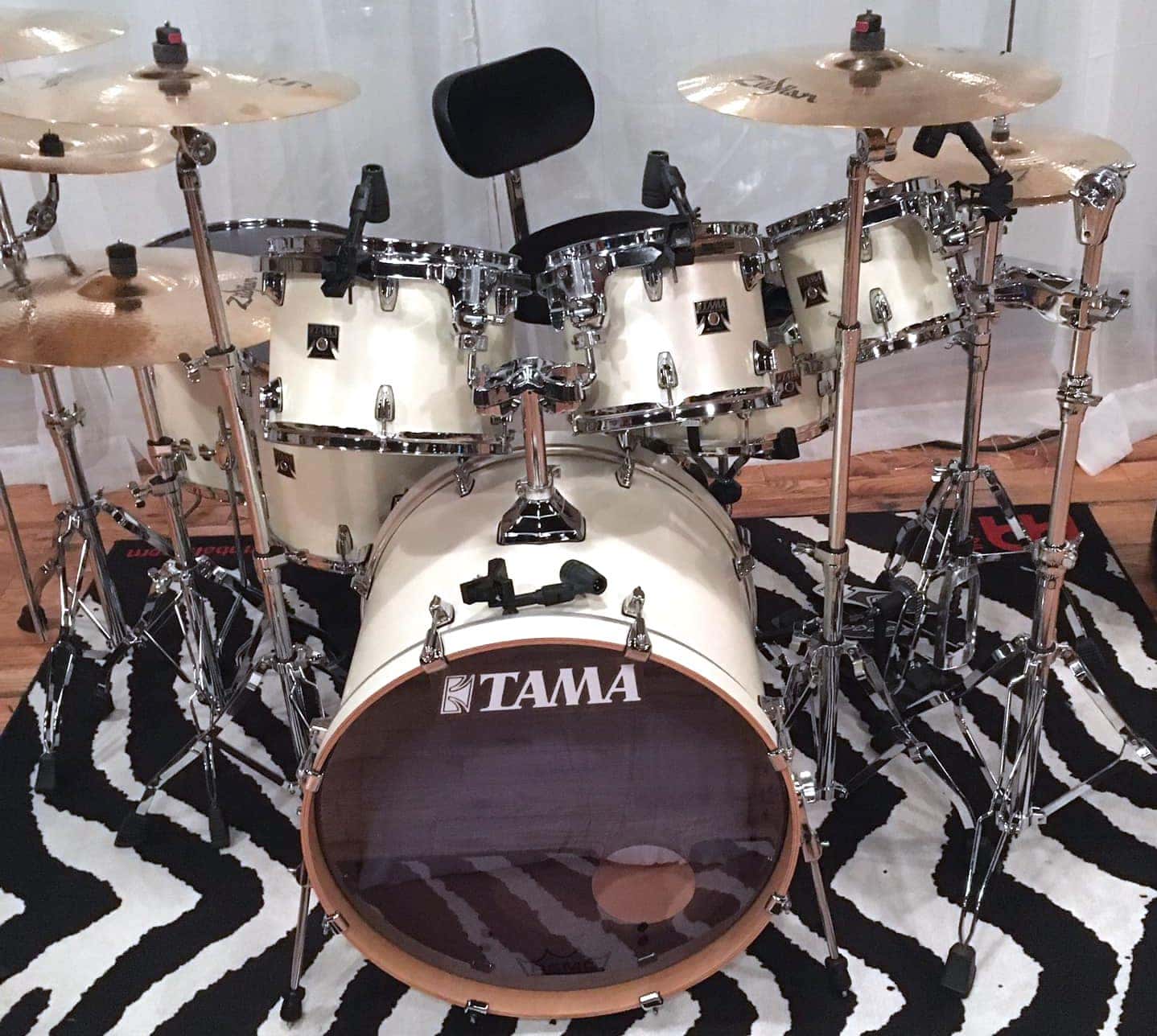
Tama Superstar Classic (this is the 7-piece kit).
Tama has a large roster of metal artists, and I’ve found that this kit works incredibly well in metal and rock drumming settings. It’s not a kit that was specifically designed for that, but it seems to cater best to that. I wouldn’t suggest using it for a jazz gig.
This kit is all about power. Regardless of your style, whether it's pop, hard rock, or metal, if you're in a high-energy band, this is the one for you.
Here's a tip when choosing the right drum kit to play in a high-energy band: choose a kick drum that, even when played extremely hard, retains a lot of the low end. The reason for this is that one of the most important aspects of playing in a band is for the bass player and drummer to be locked together as one unit.
I learned this lesson very early on after arriving in Los Angeles from the great bass player Matt Bissonette, whose brother is one of my favorite drummers of all time, Gregg Bissonette.
I was at my first recording session, and I thought I was rocking out. When I went into the control room, Matt pointed out how sometimes I did extra kicks that didn't follow the bass pattern — you could really hear it in the recording.
For that particular gig, I was playing a Tama kit because it was for a power pop artist, and it featured heavy electric guitars. So, if you're playing in either a band or a recording session where you're going to be competing with a lot of thick low-mid and low-layered instruments like amped bass, synth, or heavily distorted electric guitars, do yourself a favor and use a Tama kit.
And of course, pay attention to the bass player and stay glued to him for the whole song! Especially if you're using the Superstar Classic, because this one packs a low punch.
The one thing I love about this kit that is lacking in most of the others is a quality snare drum. The snare that’s included has a fairly wide tuning range with a crisp attack. I discovered that it opened up incredibly well the harder you hit it. The rimshot sound was beautiful to hear.
Another thing I appreciate is the quality of the hardware. Tama has a fairly good reputation for producing high-quality hardware, and it’s shown with the construction of this Superstar Classic kit.
While this kit isn’t as flashy as the others we’ve gone through, I feel that it’s a strong contender on the list. It's quite reliable and the bellowing low tones make it a great option for heavier styles of music. The tom mounts are quite good, allowing you to position the rack toms as comfortably as possible.
Unfortunately, I found the stock drum heads to be quite weak. Since the kit sounds best in lower tunings, equipping it with 2-ply heads will make a world of difference to the sound.
PROS
CONS
What's the Best Intermediate Drum Kit for YOU?
By now you've probably realized that there's no definitive answer to what's the absolute best intermediate drum set. Certain kits are better for certain genres or playing styles, while others suit different scenarios better.
Keeping that in mind, here are some factors to consider while picking out an intermediate drum kit for yourself.
How Many Drums Do You Need?
When looking into the world of intermediate drumming, the number of drums you need in your setup will differ from situation to situation.
I recommend that all beginners play on 5-piece kits (you can check out my article on 3 vs 4 vs 5 piece drum kits). It’s the best way to learn as you won’t be caught out when someone teaches you to play a middle tom.
However, intermediate drumming doesn’t require you to need every drum to learn. Intermediate drummers will know how to play many things on the drums at this stage. The question now is which setup is best for the type of music you’re playing and the gigs that you’re going to play at?
If you’re going to gig often, it will be better to get a smaller kit that is easier to carry around. If you’re going to be playing heavy metal, it will be better to get a large kit with several toms.
Most of the intermediate kits I’ve spoken about come in 5-piece or 7-piece setups. Decide how many toms you need for your unique situation and then choose accordingly.
Primary Usage - Live vs Studio
Not all of these kits are good options for studio recording. However, all of them are perfect options for playing live gigs. If you plan on doing sessions in a studio, you’ll need to choose your kit very carefully. Certain drum kits sound better through microphones than others.
My top pick from the kits we’ve gone through would be the Yamaha Stage Custom. The punchy tones from the birch shells are unmatched in the kit’s price range. It's one of the most versatile kits ever, that can get you through anything from jazz to metal (thanks to the attack and responsiveness of the birch shells).
If you use any of the other kits in a studio, then I’d suggest you swap out their snare drums for something higher-grade. You’ll also need to use good quality cymbals. The sound is often hyper-focused in studio environments, meaning you’ll always need higher-quality gear than you would need for live gigs.
Tone: Vintage or Modern?
Though none of these kits would be considered vintage, they do differ in tone quite significantly. I would say the maple kits like the PDP and Gretsch Catalina tend to skew a little bit more on the vintage warm side, while the Mapex and Tama are more modern sounding.
Once again, the Yamaha seems to be the most versatile of the bunch, being able to transcend one tone and cover many bases at the same time. It does, however, lack some of the warm low end that I would get out of the Gretsch kit.
Since most drummers use intermediate drum sets more as stepping stones toward their professional main kit, I think it's important to truly experiment and learn by customizing your intermediate drum set. Besides the typical things like replacing heads and changing up the snare, it's also important to find a drum kit that you can learn to tune well.
One of the problems with budget kits or even intermediate kits is that they don't hold up when tuning drastically. Many of these do quite well, but kits like the Tama and the Mapex could prove problematic, especially if you're tuning the toms any higher.
Also, experiment with your cymbal choices. To me, cymbals are like microphones — not every kit can use every brand, especially when you talk about hi-hats. So, when you're auditioning your intermediate drum sets, try pairing hi-hats and rides like you would a wine with a meal; pay close attention to how they complement each other.
Wrap Up
I’m always surprised at how drum manufacturers can get their drum sets under $1,000 to sound so good. Any of these intermediate kits I’ve spoken about can take you very far in your drumming journey.
It’s important to remember that they’re all shell packs. This means that they don’t come with cymbals or hardware. You’ll need to buy those things separately.
I can highly recommend saving some money and getting one of these kits. You can use the saved money to invest in higher-quality cymbals.
Also, needless to say, since I've covered only 5 kits, there are quite a few other great options for intermediate-level drummers. If you're getting a great deal all of a sudden on another kit that ticks most of the boxes I've discussed above, feel free to go ahead with it!

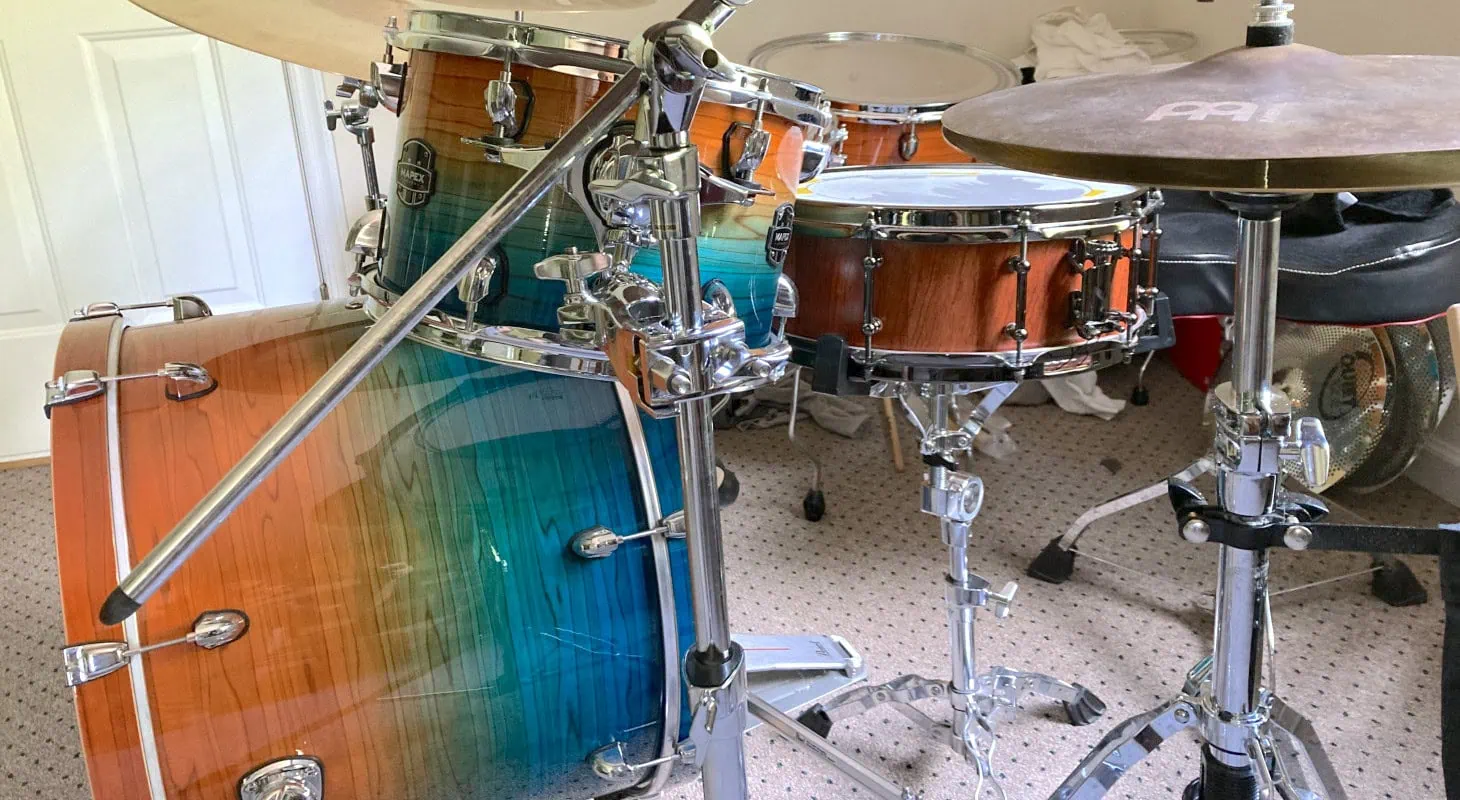
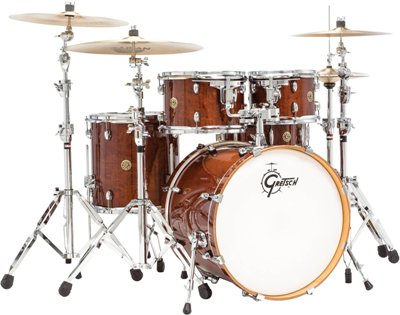

Great, easy to read, easy to understand article. Very helpful and matches well with the research I’ve done.